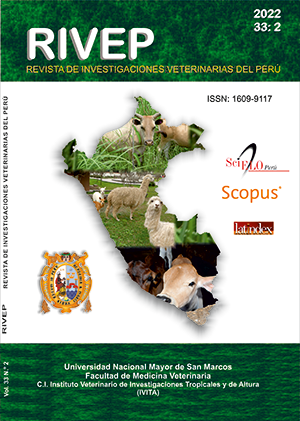Dehydration of erythrocytes parasitized with Babesia spp as an immunoprophylactic alternative. Preliminary results
DOI:
https://doi.org/10.15381/rivep.v33i2.20874Keywords:
babesiosis, immunoprophylaxis, erythrocytes, freeze-drying, spray-dryingAbstract
Immunoprophylaxis for bovine babesiosis has two presentations of a live attenuated vaccine (fresh and deep-frozen). Despite being effective, their durability, as well as the conditions necessary for their transfer and handling, make them impractical. The incorporation of a third presentation, using dehydrated merozoites as immunogens, constitutes an innovative alternative, which combines practicality and stability over time. The objective of this work was to test dehydration processes and cryopreservative and rehydrating substances. For this, erythrocytes highly parasitized with Babesia bovis and B. bigemina were subjected to two dehydration techniques: lyophilization and spray drying. In turn, for the lyophilization process, several lyoprotectants were tested: Dimethylsulfoxide, Glycerol, Dextrose and Polyvinylpyrrolidone (PVP). The only one that achieved a properly dehydrated powder, crystalline in appearance and brittle to the touch was the PVP. Subsequently, the erythrocytes obtained by both techniques were reconstituted with sucrose solutions (0.25, 0.5, 1 M), 0.9% saline solution, Vega y Martínez solution, phosphate buffer and distilled water. Optical microscopy with an immersion objective showed that the best reconstituent for both lyophilized and spray-dried red blood cells was the 0.25 M sucrose solution, showing a high number of lyophilized and reconstituted red blood cells with preserved morphology. Extrapolating these results to the haemoparasites under study, their application as immunogens would be promising.
Downloads
Downloads
Published
Issue
Section
License
Copyright (c) 2022 Florencia Del Río Álvarez, María E. Peichoto, Santiago Palma; Belkys Maletto; Marcos Guidoli, Laura Huber, Laura Lozina

This work is licensed under a Creative Commons Attribution 4.0 International License.
AUTHORS RETAIN THEIR RIGHTS:
a. Authors retain their trade mark rights and patent, and also on any process or procedure described in the article.
b. Authors retain their right to share, copy, distribute, perform and publicly communicate their article (eg, to place their article in an institutional repository or publish it in a book), with an acknowledgment of its initial publication in the Revista de Investigaciones Veterinarias del Perú (RIVEP).
c. Authors retain theirs right to make a subsequent publication of their work, to use the article or any part thereof (eg a compilation of his papers, lecture notes, thesis, or a book), always indicating the source of publication (the originator of the work, journal, volume, number and date).



